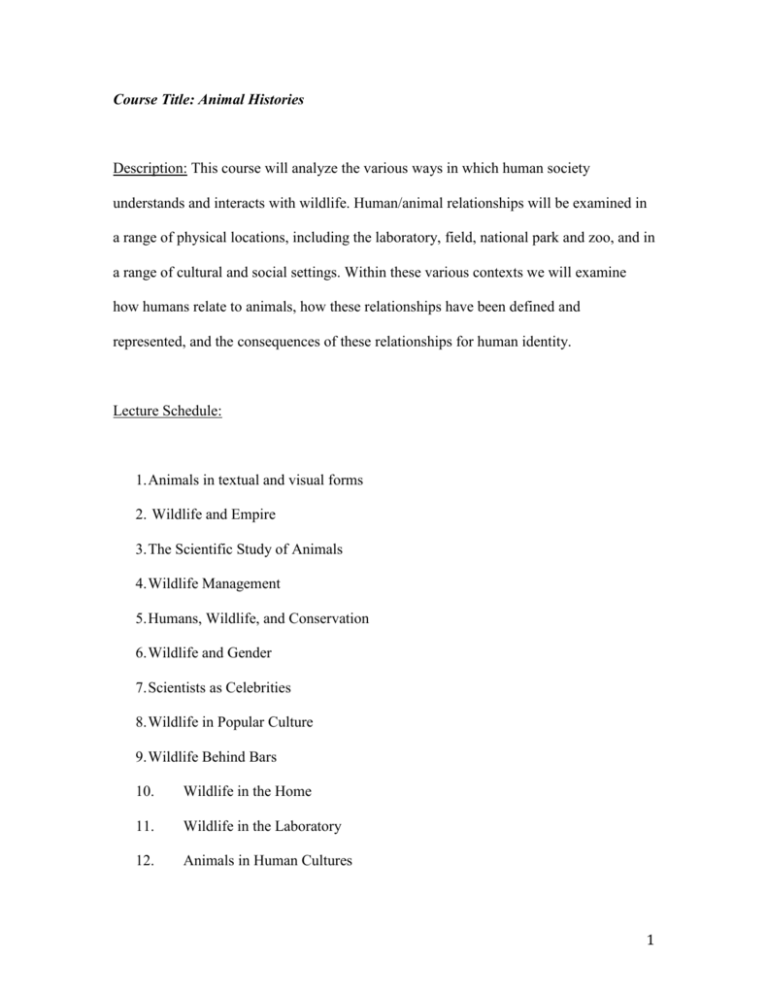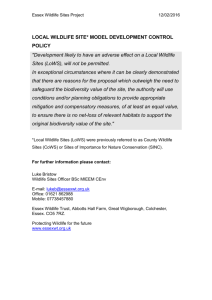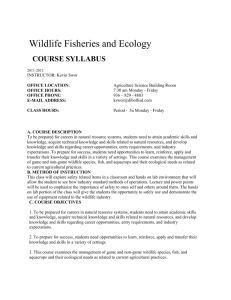Animal Histories: Georgina Montgomery and Linda Kalof
advertisement

Course Title: Animal Histories Description: This course will analyze the various ways in which human society understands and interacts with wildlife. Human/animal relationships will be examined in a range of physical locations, including the laboratory, field, national park and zoo, and in a range of cultural and social settings. Within these various contexts we will examine how humans relate to animals, how these relationships have been defined and represented, and the consequences of these relationships for human identity. Lecture Schedule: 1. Animals in textual and visual forms 2. Wildlife and Empire 3. The Scientific Study of Animals 4. Wildlife Management 5. Humans, Wildlife, and Conservation 6. Wildlife and Gender 7. Scientists as Celebrities 8. Wildlife in Popular Culture 9. Wildlife Behind Bars 10. Wildlife in the Home 11. Wildlife in the Laboratory 12. Animals in Human Cultures 1 13. Animals, Anthropomorphism, and Human Identity Course Texts: Gregg Mitman’s Reel Nature (1999) was a required text for this course, supplemented by a range of articles and book chapters representing secondary and primary sources. Assignments: Weekly reading response papers ensured students fully engaged with the reading and came to class ready to discuss the text(s) in depth. Such opportunities for reflection and analysis are valuable when exploring complex historical topics. Furthermore, the papers provided students with a forum to develop their skills of argumentation in preparation for their final research paper, the topic for which was selfselected. We feel it is important to assign research papers that allow students to compose their own research topic and thesis within the themes of the course. The flexibility of such assignments encourages original research on topics of intellectual and often personal interest to the student. 1b. Sample Undergraduate Course Harriet Ritvo, at Massachusetts Institute of Technology, has taught the following course in the Department of History. In recent years, the course has been adapted to allow graduate students to take the class, with a longer final research paper being required for such students. Ritvo draws on works from the history of science, environmental history, the history of medicine, and historical literature. Course Title: People and Other Animals 2 Course Description: A historical survey of the ways that people have interacted with their closest animal relatives, for example: hunting, domestication of livestock, worship of animal gods, exploitation of animal labor, scientific study of animals, display of exotic and performing animals, and pet keeping. Themes include changing ideas about animal agency and intelligence, our moral obligations to animals, and the limits imposed on the use of animals. Lecture Schedule: 1. The Hunt 2. Domestication and Breeding 3. Meat (or not) 4. Pets 5. Animal Exploitation and Animal Protection 6. Animals and Infection 7. Animals on Display 8. Studying Animals: Field Observation, Experimentation and Imagination 9. Studying Animals: Field Observation and Ethology 10. Studying Animals: Documentary Film Course Texts: A range of readings were assigned in addition to the following required texts: Sarah Franklin, Dolly Mixtures (2007), Anita Guerrini, Experimenting with 3 Humans and Animals (2003), Vicki Hearne, Adam’s Task (2007), Harriet Ritvo, Animal Estate (1987), Anna Sewell, Black Beauty (1877/1905), Noelie Vialles, Animal to Edible (1994), and H.G. Wells, The Island of Doctor Moreau (1898). Assignments: This course involves weekly reading response papers and culminates in a final research paper. During the semester, students hand in a proposal, bibliography, and progress report. These materials enable Ritvo to become familiar with the student’s writing style and connection with the material. 4 Sample Graduate Course Kalof has taught the following course at the 800-level at Michigan State University. This course offers a species focus and uses a range of books and articles that explore the history of domestication, hunting, animal symbolism, and animals in art. Course Title: Animals and Social Transformations Course Description: This graduate course is a historical overview of the cultural relationship between humans and other animals and how those relationships have changed with changing social conditions. We will use both visual imagery and extracts from historical and literary sources to experience the human-animal story from prehistory through postmodernity. The course draws on a wealth of information about the animalhuman relationship, covering a range of topics rarely discussed in animal studies, such as the Black Plague, dead animal portraiture and animal rituals that reflect hierarchies of gender, race and class, including the medieval backwards ride, horning ceremonies and animal massacres. Animals and Social Transformations is taught every Spring primarily to graduate students in sociology, history and anthropology, but is open to all interested graduate students. Lecture Schedule: 2-3 weeks were spent on each of the following topics: 5 1. Animals in Prehistory 2. Animals in Antiquity 3. The Horse through History 4. Animals in the Middle Ages 5. Animals in the Renaissance 6. Animals in the Enlightenment 7. Animals in Modernity Course Texts: Linda Kalof's, Looking at Animals in Human History (2007) and Juliet Clutton-Brock's, Horse Power (1992) were required texts that were supplemented by various articles and book chapters. Assignments: Weekly papers summarizing and responding to the readings allowed for indepth reflection and discussion of assigned topics. A final research paper allowed for original research on a topic of the student’s choice. 6








